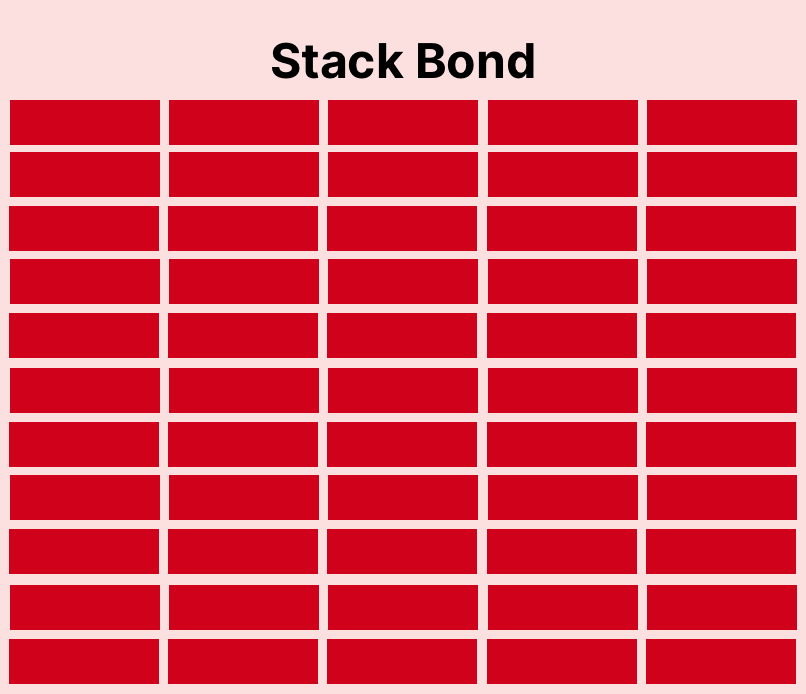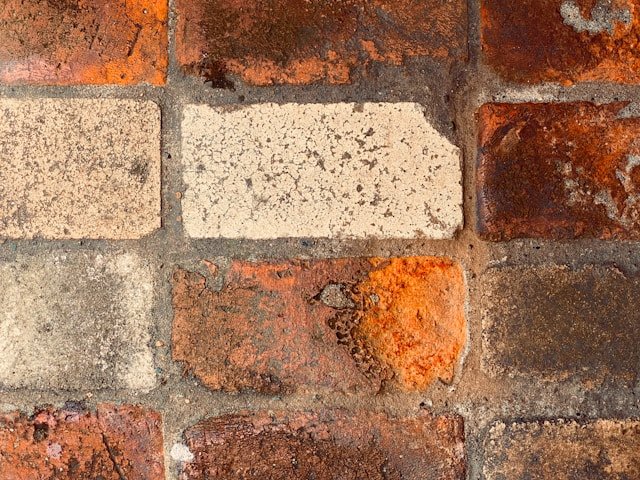Exploring the Stack Bond in Masonry
Ever wondered why an aesthetically pleasing design of a building has caught your attention?
Chances are, it may involve the use of a “stack bond”. Stack bonds are becoming increasingly popular in modern architecture due to their simplistic yet bold appeal. But do you know what a stack bond really is or why it’s used?
Just as the name suggests, a stack bond involves stacking blocks or bricks directly on top of each other in a straight line. This creates a clean, uniform look. However, it’s worthwhile to note that this pattern has less horizontal strength compared to other layout styles. Therefore, stack bonds are primarily used for aesthetic appeal and non-load-bearing applications.
Read further in this article to gain a deeper understanding about stack bonds. What sets them apart from other bonds? How does their distinct alignment impact their architectural and functional purposes? What are the considerations one must make when installing stack bonds?
We’ll cover all these aspects and more.
Table of Contents
What is the Purpose of a Stack Bond?

Definition of a Stack Bond
In masonry construction, a stack bond is a brickwork pattern where bricks are laid directly on top of one another in a straight vertical line. Unlike other bonds like the running bond where bricks overlap, in a stack bond, the vertical joints align continuously through each course.
Key Characteristics of a Stack Bond
- Vertical alignment: Bricks or blocks are stacked in perfect vertical rows.
- Uniform look: Creates a clean and modern aesthetic.
- Less overlap: Compared to other bonds, there’s minimal interlocking.
Primary Purpose of a Stack Bond
1. Architectural Design: Stack bonds are primarily used for their visual appeal. The uniformity and clean lines can make buildings look sleek and modern.
2. Non-load Bearing Walls: Due to the lack of horizontal strength, stack bonds are generally used in non-load-bearing walls. These could be partition walls or decorative facades.
Comparing Bond Types: Running Bond vs. Stack Bond
| Aspect | Running Bond | Stack Bond |
|---|---|---|
| Joint Overlap | Each brick overlaps the one below | Vertical joints align |
| Strength | Higher flexural strength | Lower flexural strength |
| Visual Style | Traditional | Modern |
Examples of Stack Bond Applications
– Facade Walls: Commonly used in modern architecture to create a smooth and symmetrical appearance.
– Interiors: Ideal for feature walls or backsplashes in homes to provide a contemporary look.
– Partitions: Used in creating non-load-bearing partitions where structural strength is not a priority.
Installation Considerations
When installing stack bonds, it’s essential to:
- Ensure symmetrical alignment to maintain its visual appeal.
- Understand that additional structural support may be required, especially for load-bearing applications.
- Use proper mortar and techniques to compensate for its reduced strength compared to other bonds. According to The Balance, correct mortar use is essential for the integrity of masonry structures.
The Aesthetics of a Stack Bond

The Modern Appeal of Stack Bond Masonry
In the world of masonry construction, innovations promoting a contemporary and clean finish are always emerging and trending.
One such innovation is the stack bond, celebrated for its minimalistic and harmonious balance. Its profile exerts a simplicity that is eye-catching yet understated, establishing a fresh and timeless design.
The uniformity of a stack bond pattern introduces a robust backdrop which can effectively showcase and highlight architectural features. For instance, the vertical lines might draw attention to a building’s height, creating an impression of grandeur. Similarly, the use of contrasting coloured bricks can develop an alternating interplay of dark and light hues, bringing subtlety to a building’s facade.
Geometric Patterns and Stack Bond
The stack bond pattern is not only limited to a straight vertical alignment of bricks; it can also include other geometric patterns. The repetitive, straight lines provide a base for creativity, as designers can conceptualize a multitude of arrangements from zigzags to cross hatching. This flexibility amplifies the visual potential of stack bond, making it a preferred choice in diverse architectural design styles.
Limitations of a Stack Bond

Strength and Structural Concerns
Though a stack bond excels in the aesthetic domain, it brings its own set of challenges when it comes to structural integrity. Primarily, the stack bond doesn’t have the inherent strength of other masonry bond patterns. The straight alignment of bricks causes a weak horizontal strength—an important factor to consider when designing for seismic zones or high-wind areas.
Since the lack of overlapping bricks means the bonds don’t interlock, cracks can appear over time along the mortar. This makes stack bonds less suitable for load-bearing walls or retaining structures, where stability and durability are critical.
Maintenance of Stack Bond Brickwork
Stack bond brickwork often requires regular maintenance. Since bricks are prone to efflorescence—a white, powdery deposit of salts that can appear on the surface of the material—the bricks and mortar may need to be sealed to avoid this. Regular inspections are also required to ensure the structural wellbeing of the wall, as the load-bearing capacity is not on par with other bond types.
Choosing the Right Bond
Beyond Aesthetics: The Right Bond for the Right Application
Selecting the right masonry bond isn’t solely about aesthetics, it’s also about the necessities of the project. When considering using a stack bond, designers will need to weigh the visual appeal against the potential structural implications and plan accordingly.
While stack bonds may be a visually appealing choice for a project, it’s critical that they are deployed in an appropriate context. In areas that require higher structural strength, or when creating load-bearing walls, the feasibility of a stack bond needs to be thoroughly assessed. It might be necessary to use reinforcements or supplemental structural support, facts architects should take into account.
At the end of the day, whether or not a stack bond is the right choice depends on the overall design intention, functionality, and application of the structure in question. When the cards are played right, the stack bond can bring simplicity, elegance, and a modern flair to any design.
Disadvantages of Stack Bonds in Masonry
Structural Limitations
One of the primary disadvantages of using a stack bond in masonry is its lack of structural strength. Unlike traditional bond patterns, such as the running bond, that stagger bricks to enhance bonding and load distribution, stack bonds involve bricks aligned vertically without overlap. This results in:
– Low Horizontal Strength: The absence of interlocking bricks reduces the wall’s resistance to horizontal stresses like wind or seismic activity.
– Vulnerability to Cracks: Continuous vertical joints mean cracks can propagate through entire courses easily, compromising the wall’s integrity over time.
Load-Bearing Constraints
Stack bonds are generally not suitable for load-bearing structures due to their reduced strength. They are often used in non-load-bearing walls such as facades and partitions. Using stack bonds for load-bearing applications would require extensive reinforcement:
– Additional Reinforcement: To make stack bond walls suitable for bearing loads, steel reinforcements or concrete infill must be added. This increases both the complexity and cost of construction.
– Higher Maintenance: Reinforced stack bond walls may require regular inspections and maintenance to ensure their structural integrity, further adding to long-term costs.
Maintenance Challenges
Maintenance is another concern when it comes to stack bonds. The uniform alignment can lead to more pronounced wear and tear, and proper upkeep is necessary to maintain their visual and structural effectiveness:
– Efflorescence Issues: Like other masonry types, stack bonds can suffer from efflorescence. This aesthetic defect occurs when water-soluble salts migrate to the surface, creating a white, powdery deposit that may require cleaning or sealing.
– Regular Inspections: Given the structural vulnerabilities, stack bonds may need more frequent inspections to check for cracks and mortar deterioration. Continuous vertical joints can often disguise early signs of structural failure, escalating into bigger problems if unnoticed.
Cost Implications
Using stack bonds can also lead to higher costs, both in terms of initial construction and ongoing maintenance:
– Construction Costs: The requirement for additional reinforcements and specialized installation techniques can increase the initial costs.
– Long-term Costs: Regular maintenance and the need for potential repairs due to structural weaknesses add to ongoing expenditures.
Design Limitations
While stack bonds offer a sleek, modern aesthetic, they come with design limitations:
– Limited Structural Applications: The reduced structural strength means stack bonds can’t be used for a wide range of applications. They are best suited for decorative purposes rather than functional, load-bearing roles.
– Dependence on Reinforcement: The reliance on external supports for structural integrity means that designers must carefully integrate these elements into their plans, potentially limiting creative freedom.
Conclusion: Appreciating the Stack Bond’s Balance of Aesthetics and Challenges
In the context of masonry architecture, the stack bond stands out due to its distinct visual appeal.
With its streamlined, contemporary aesthetic, it commands attention with its harmonious balance and modern charm. The versatility of stack bond further broadens its allure, accommodating numerous creative geometric designs.
However, the adoption of stack bonds comes with its own hurdles revolving around structural integrity and maintenance demands. The absence of brick overlap in stack bonds results in reduced horizontal strength, amplifying vulnerability towards cracking, making it less suitable for load-bearing applications. Regular maintenance, costly reinforcements, and extensive planning thus become integral parts of using stack bonds.
Despite these challenges, architects who consider the project’s functional and aesthetic needs can effectively employ stack bonds to create impressive designs. Used appropriately, a stack bond can infuse simplicity and a refreshing modern flair in any structure.
Frequently Asked Questions – FAQs
What is the primary use of a stack bond in masonry?
Stack bonds are mostly used for their visual appeal, which gives buildings a sleek, modern look. They’re often used in non-load-bearing walls like partition walls and decorative facades due to their lower structural strength.
What are some advantages of using stack bonds?
Stack bonds provide a clean, uniform look that’s attractive and modern. They also provide architects the opportunity to experiment with various geometric patterns, elevating the design potential of a stack bond.
What are the disadvantages of using stack bonds?
Stack bonds have lower horizontal strength compared to other bond types, which can result in a weaker structure and potential for cracks. Maintenance, both in terms of cost and time, with stack bonds can also be higher due to these structural weaknesses.
Are stack bonds suitable for load-bearing walls?
Generally, stack bonds are not recommended for load-bearing walls due to their lesser structural strength. However, additional reinforcements can be added to make them suitable for this purpose, albeit at an additional cost and complexity.






